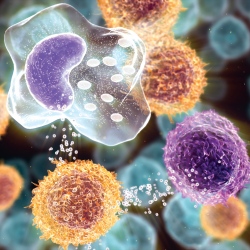
Researchers at the University of Georgia have refined the nanoparticle drug delivery process further by using nanoparticles to deliver drugs to a specific organelle within cells.
By targeting mitochondria, “the powerhouse of cells,” the researchers increased the effectiveness of mitochondria-acting therapeutics used to treat cancer, Alzheimer’s disease and obesity in studies conducted with cultured cells.
“The mitochondrion is a complex organelle that is very difficult to reach, but these nanoparticles are engineered so that they do the right job in the right place,” said senior author Shanta Dhar, an assistant professor of chemistry in the UGA Franklin College of Arts and Sciences.
Dhar and her co-author, doctoral student Sean Marrache, used a biodegradable, FDA-approved polymer to fabricate their nanoparticles and then used the particles to encapsulate and test drugs that treat a variety of conditions. Their results were published this week in early edition of the journal Proceedings of the National Academy of Sciences.
Targeting increased the effectiveness of the cancer drugs by more than 100 times
To test the effectiveness of their drug targeting system against cancer, they encapsulated the drug lonidamine, which works by inhibiting energy production in the mitochondria, and, separately, a form of the antioxidant vitamin E. They then treated cultured cancer cells and found that mitochondrial targeting increased the effectiveness of the drugs by more than 100 times when compared to the drugs alone and by five times when compared to the delivery of drugs with nanoparticles that target the outside of cells.
Similarly, the compound curcumin has shown promise in inhibiting formation of the amyloid plaques that are a hallmark of Alzheimer’s disease, but it quickly degrades in the presence of light and is broken down rapidly by the body. By encapsulating curcumin in the mitochondria-targeting nanoparticles, however, the researchers were able to restore the ability of brain cells in culture to survive despite the presence of a compound that encourages plaque formation. Nearly 100 percent of the cells treated with the mitochondria-targeting nanoparticles survived in the presence of the plaque-inducing compound, compared to 67 percent of cells treated with free curcumin and 70 percent of cells treated with nanoparticles that target the outside of cells.
Finally, the researchers encapsulated the obesity drug 2,4-DNP — which works by making energy production in the mitochondria less efficient — in their nanoparticles and found that it reduced the production of fat by cultured cells known as preadipocytes by 67 percent compared to cells treated with the drug alone and by 61 percent of cells treated with nanoparticles that target the outside of cells.
“A lot of diseases are associated with dysfunctional mitochondria, but many of the drugs that act on the mitochondria can’t get there,” Marrache said. “Rather than try to alter the drugs, which can reduce their effectiveness, we encapsulate them in these nanoparticles and precisely deliver them to the mitochondria.”
